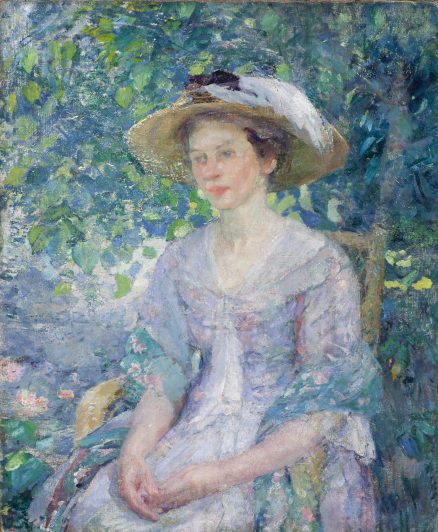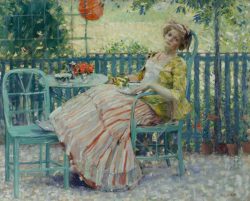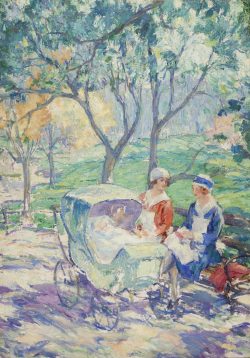Untitled (In the Garden, Giverny)
, circa 1908–1912Oil on canvas, 28 by 33¼ inches
- Categories
- Figural works
- Immigrant artists
- Women
- Zoom in on Artwork
- Print Page
- Email Page to Friend
Seated outdoors, the young woman in Karl Buehr’s painting poses demurely, her hands gathered in her lap and a slight smile on her lips as she gazes off to the left. Her broad straw hat, open-necked white dress, and green floral shawl are appropriate to the light and heat of a bright summer day. She shelters under the lush foliage of a pear tree that fills the upper half of the composition. Buehr was an accomplished portraitist, and this sitter is posed and framed according to conventions for three-quarter-length seated portraits. Neither her identity nor the painting’s original title is known, however. Buehr never parted with this work, which suggests that it held personal significance. Perhaps it is a portrait of his wife, painter Mary Hess Buehr, although no wedding ring is visible on the woman’s hand.
With its harmonious cool pastel tints dominated by greens and its heavily worked surface, In the Garden, Giverny almost certainly dates to the years between 1909 and 1912, when the Buehrs spent long periods in Giverny, France. Home of celebrated French Impressionist painter Claude Monet, the Normandy village had attracted scores of American and other foreign painters beginning in the late 1880s. By 1909, the Giverny colony’s leading members, including Lawton Parker and Louis Ritman, were painting lushly tinted images of women at leisure—their wives as well as hired models—posed in sun-dappled gardens or light-filled rooms. Buehr too pictured women in garden or terrace settings, often dallying over alfresco meals, as in A Restful Moment. In contrast, the portrait-like Untitled (In the Garden, Giverny) shows little of the setting beyond dense foliage, and may represent an earlier moment in the artist’s transition to painting the figure out-of-doors. Compositionally, the painting is reminiscent of The Seeker, Pauline Dohn’s acclaimed work made about a decade earlier in rural Holland. Although both images show the female figure set against a pear tree, Buehr’s emphasizes the effects of indirect natural light in its rich silvery tones. It anticipates the preoccupation with decorative surface pattern that would characterize his later paintings of women.
Wendy Greenhouse, PhD
Donated by M. Christine Schwartz to Lake Forest College, Lake Forest, Illinois, in 2021


